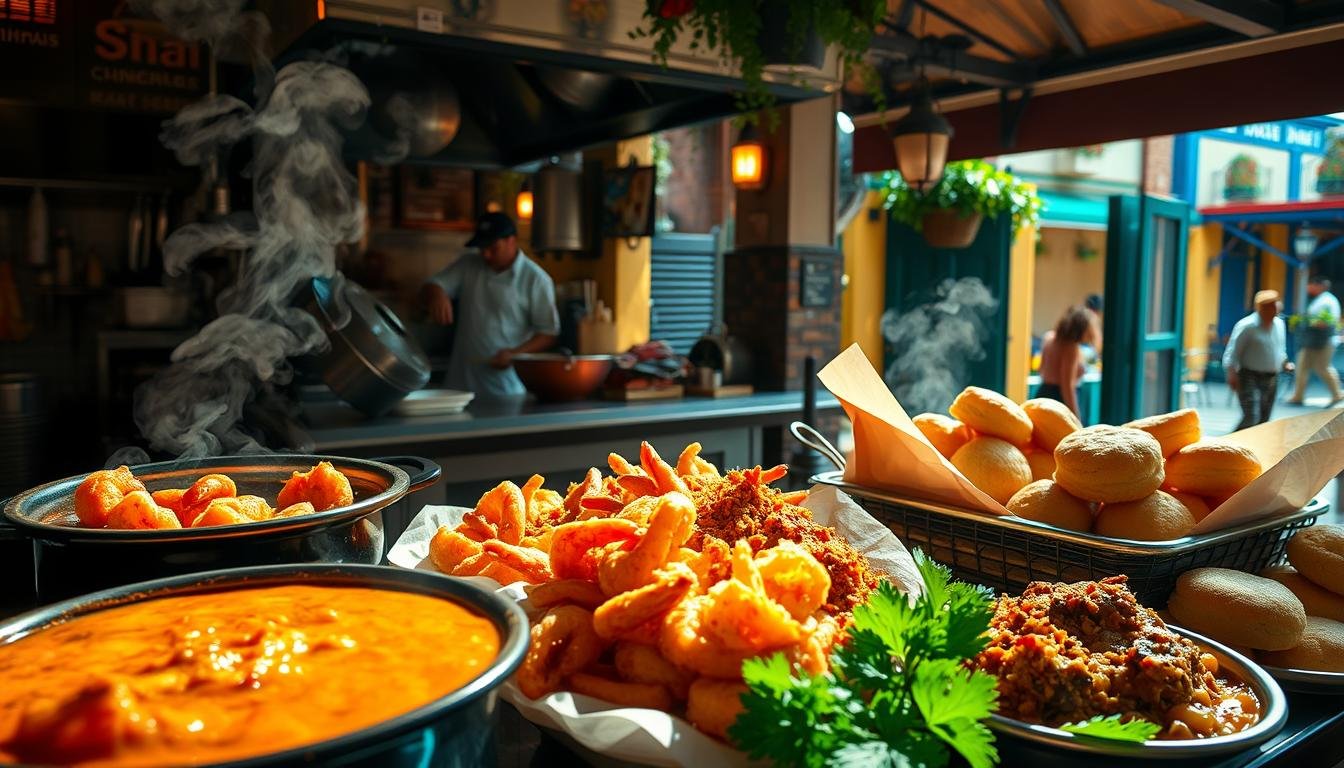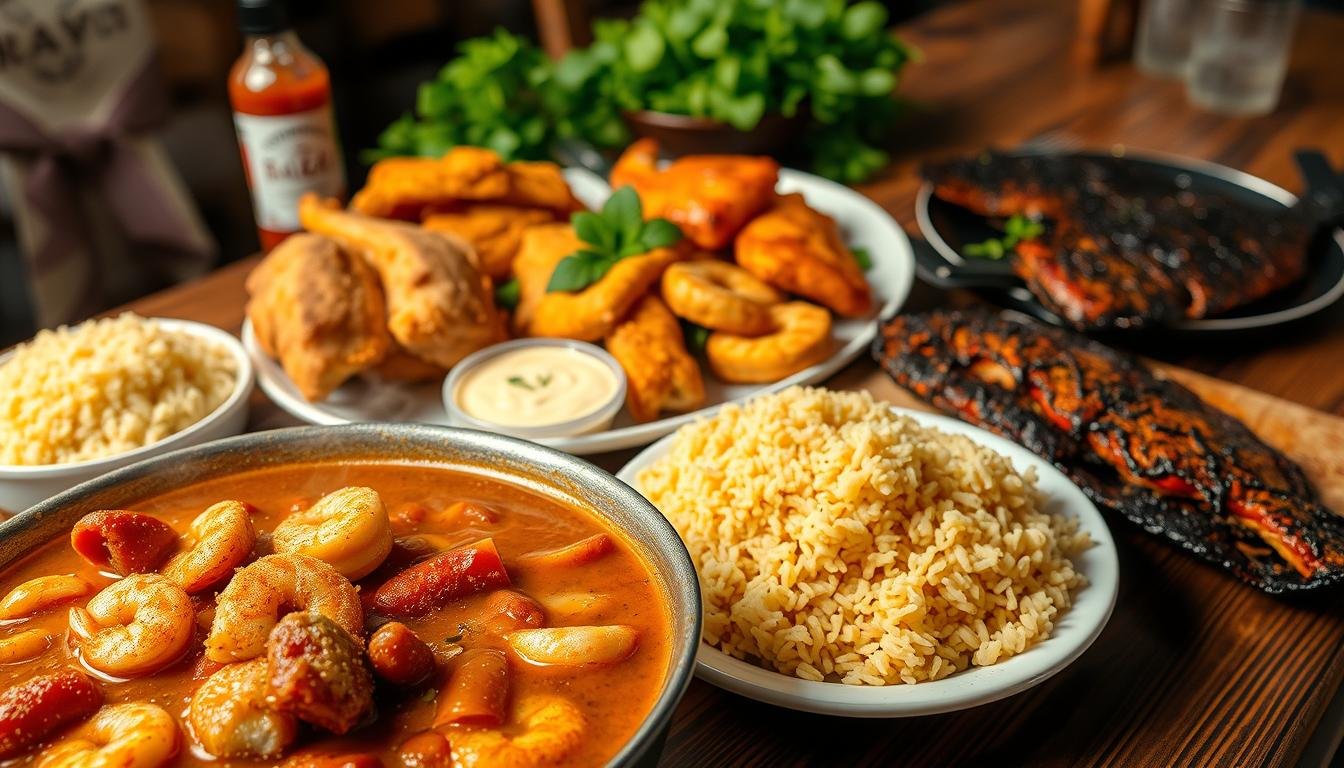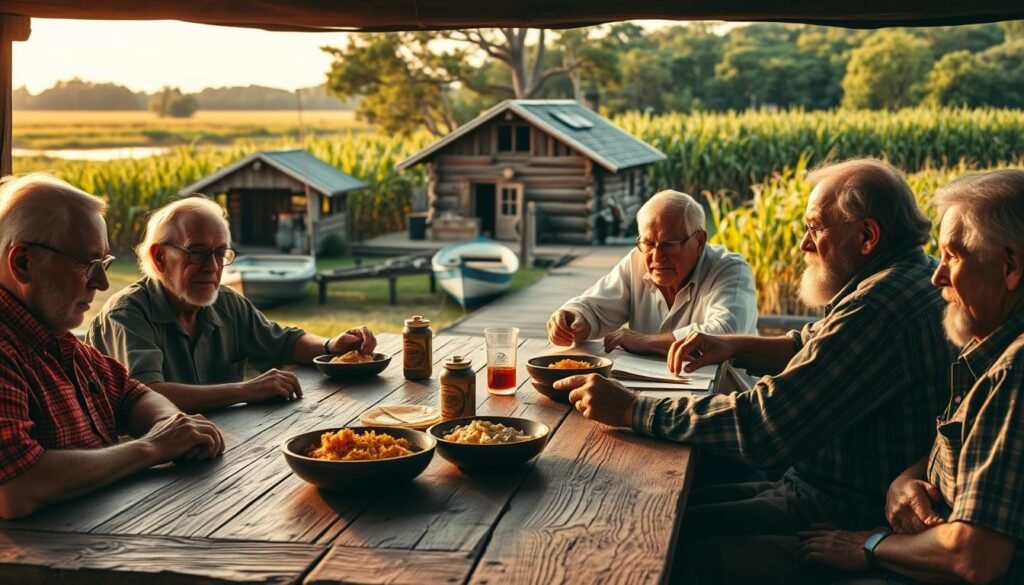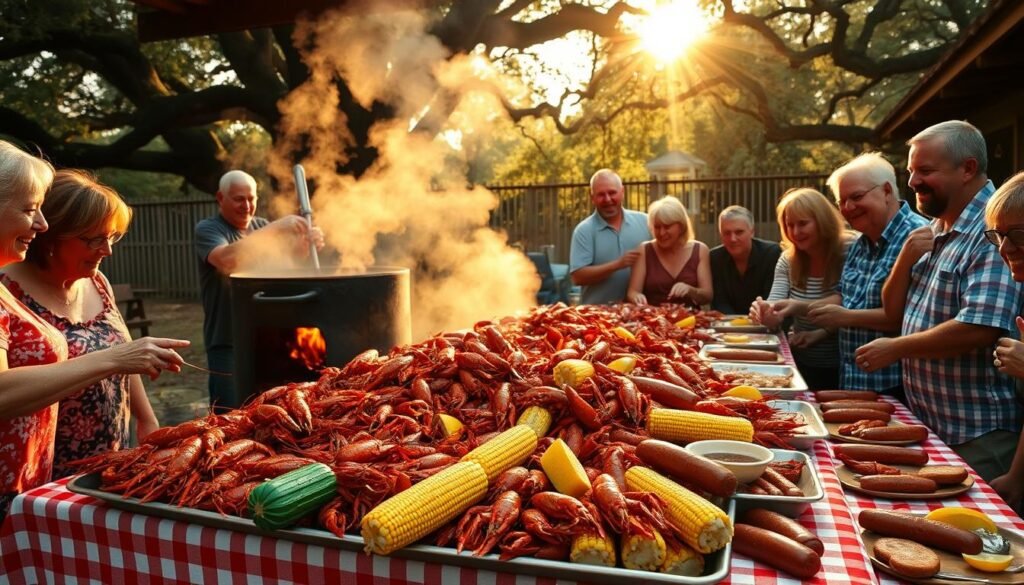Growing up in this vibrant city, I’ve had the pleasure of savoring the bold flavors and spices that define our culinary identity. As a local, I’m excited to share with you the rich flavors of Cajun food that make our city so special.
We’ll embark on a journey to explore the world of authentic Cajun dishes, from its origins to the best places to try it. With a blend of traditional wisdom and modern outlook, we’ll dive into the key ingredients, iconic dishes, and cooking techniques that make our cuisine so unique.
Key Takeaways
- Discover the rich history and cultural significance of Cajun cuisine
- Learn about the key ingredients and cooking techniques used in traditional Cajun dishes
- Explore the best places to try authentic Cajun food in New Orleans
- Get insider tips on how to make the most of your culinary experience
- Understand the importance of preserving and sharing authentic New Orleans culture
Introduction to Cajun Cuisine
The story of Cajun cuisine begins in the 18th century with the arrival of French-speaking Acadians in Louisiana. These Acadians, who would later become known as Cajuns, brought with them their rich culinary traditions, which would eventually blend with the cooking styles of other cultures in the region.
Cajun cuisine is characterized by its use of locally sourced ingredients, bold flavors, and simple preparation methods. At its core, it’s a cuisine that celebrates the resourcefulness and resilience of the Acadian people, who made the most of the ingredients available to them in their new environment.
The Origins of Cajun Cooking
Cajun cooking has its roots in the traditional cuisine of the Acadian people, who were originally from Canada. When they arrived in Louisiana, they found a new environment with different ingredients, which they incorporated into their cooking. Over time, their cuisine evolved to include a mix of French, Spanish, African, and Native American influences.
The Acadians were skilled hunters and farmers, and their cuisine reflected their ability to make the most of the resources available to them. They developed a range of dishes that were hearty, flavorful, and often made with ingredients that were readily available in the region.
Influences on New Orleans Cuisine
New Orleans, with its strategic location on the Mississippi River, has long been a melting pot of cultures. The city’s cuisine, including its Cajun traditions, has been shaped by the influences of various cultures, including African, Spanish, and Native American.
The blending of these cultures has resulted in a unique flavor profile that is characteristic of New Orleans cuisine. From the use of spices and seasonings to the preparation methods and ingredient combinations, the city’s culinary identity is a reflection of its rich cultural heritage.
As we explore the world of Cajun cuisine, we’ll delve deeper into the traditional cajun flavors that have come to define this unique culinary tradition. By understanding the history and cultural influences that have shaped Cajun cooking, we can gain a deeper appreciation for the rich culinary heritage of New Orleans.
Key Ingredients in Cajun Dishes
At the core of Cajun cooking are a few simple yet essential ingredients. These components form the backbone of many traditional dishes, giving them their distinctive flavor and character.
The Holy Trinity
The Holy Trinity – onions, bell peppers, and celery – is the foundation of many authentic Cajun dishes. This trio is sautéed at the beginning of most recipes to create a flavorful base. Onions add a sweet depth, bell peppers contribute a crunchy texture and slightly sweet flavor, while celery brings a fresh, herbal note.
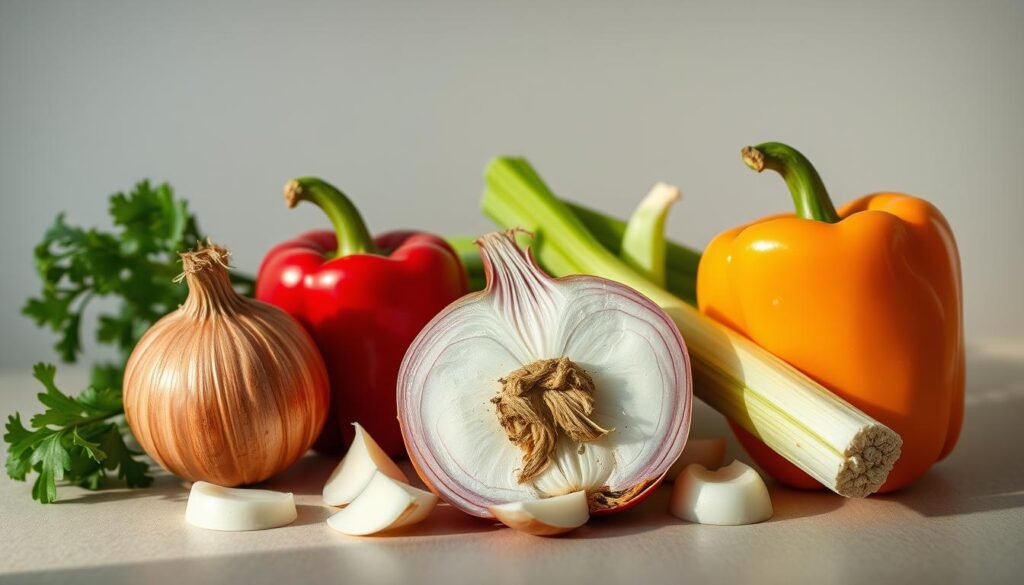
When combined, these three ingredients create a harmonious balance that enhances the overall taste of the dish. Whether you’re making a hearty gumbo or a spicy jambalaya, the Holy Trinity is an indispensable starting point.
Popular Spices and Seasonings
Cajun cuisine is known for its bold flavors, thanks in large part to the popular Cajun dishes being seasoned with a blend of spices and herbs. Paprika, cayenne pepper, thyme, and oregano are staples in many kitchens.
| Spice/Seasoning | Flavor Profile | Common Use |
|---|---|---|
| Paprika | Mild, slightly sweet | Gumbo, stews |
| Cayenne Pepper | Hot, spicy | Jambalaya, sauces |
| Thyme | Herbal, slightly minty | Soups, stews |
| Oregano | Pungent, earthy | Meat dishes, marinades |
The combination and proportion of these spices can vary greatly depending on the recipe and personal preference. However, they all contribute to the characteristic flavor profile of Cajun food New Orleans style.
Understanding these key ingredients and how they’re used is crucial to appreciating the complexity and richness of Cajun cuisine. Whether you’re a local or just visiting, knowing the role of the Holy Trinity and the spices that season our dishes will deepen your appreciation for this unique culinary tradition.
Iconic Cajun Dishes to Try
From spicy jambalaya to rich gumbo, Cajun cuisine offers a diverse array of dishes that are sure to tantalize your taste buds. Whether you’re dining at one of the best Cajun restaurants in New Orleans or cooking at home, these iconic dishes are a must-try.
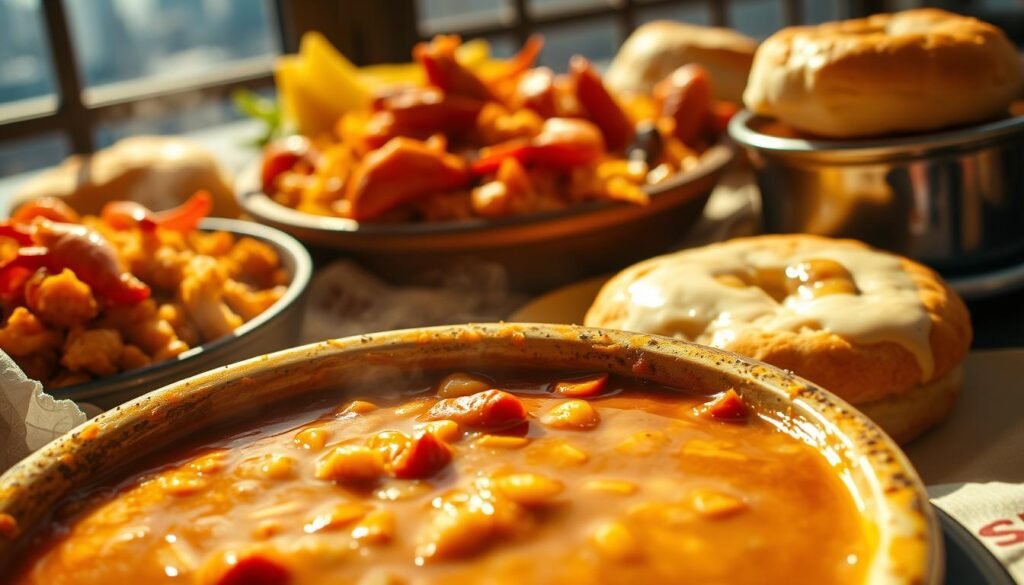
Jambalaya: A Flavorful One-Pot Meal
Jambalaya is a quintessential Cajun dish that’s as hearty as it is flavorful. This one-pot meal combines sausage, chicken, and a variety of spices with rice, creating a culinary experience that’s both filling and delicious. When looking for where to find Cajun food in New Orleans, jambalaya is a dish that’s often at the top of the menu.
As a local favorite, jambalaya is more than just a meal; it’s a reflection of the community’s spirit. It’s often served at gatherings and celebrations, bringing people together over its savory flavors.
Gumbo: A Stew with Deep Roots
Gumbo is another iconic Cajun dish that showcases the depth and richness of New Orleans Cajun cuisine. This stew is made with a combination of ingredients, including okra, rice, and a variety of meats and seafood, all blended together with a dark roux that gives it a distinctive flavor and texture.
“Gumbo is to New Orleans what pizza is to New York – it’s a culinary staple that everyone has their own version of, and it’s a dish that’s deeply rooted in the culture and history of the city.”
The beauty of gumbo lies in its versatility; it’s a dish that’s been adapted and modified over the years, with each family having their own secret recipe. Whether you try it at a local restaurant or make it yourself, gumbo is sure to become a favorite.
Crawfish Étouffée: A Louisiana Classic
Crawfish étouffée is a dish that highlights the simplicity and elegance of Cajun cooking. Made with crawfish, vegetables, and a roux-based sauce, étouffée is a flavorful and satisfying meal that’s often served over rice. It’s a dish that’s deeply rooted in Louisiana’s culinary traditions and is a must-try when exploring Cajun cuisine in New Orleans.
- Look for étouffée on menus throughout the city, often made with fresh, locally sourced crawfish.
- Try it with a side of crusty French bread for a truly authentic experience.
- For a unique twist, some restaurants offer variations that include other seafood or spices.
Exploring these iconic Cajun dishes is a journey into the heart of New Orleans Cajun cuisine. Whether you’re a local or just visiting, these dishes are sure to leave you with a deeper appreciation for the culture and culinary traditions of the region.
Cooking Techniques for Cajun Food
In the heart of Cajun cooking lies a set of techniques that have been passed down through generations, shaping the flavors of New Orleans. These methods are crucial for creating the rich, bold dishes that Cajun cuisine is known for. From the sizzling pans of a bustling kitchen to the slow-cooked stews simmering on the stovetop, each technique plays a vital role in bringing out the unique flavors of traditional Cajun flavors.
The Art of Sautéing
Sautéing is a fundamental technique in Cajun cooking, used to quickly cook ingredients in a pan with a small amount of oil or fat. This method is essential for developing the deep flavors found in many Cajun dishes. To sauté effectively, it’s crucial to use high heat and stir the ingredients frequently to prevent burning. The key is to cook the ingredients just until they’re tender, preserving their texture and flavor. For instance, sautéing the Holy Trinity (onions, bell peppers, and celery) is a common starting point for many Cajun recipes, as it lays a flavorful foundation for the dish.
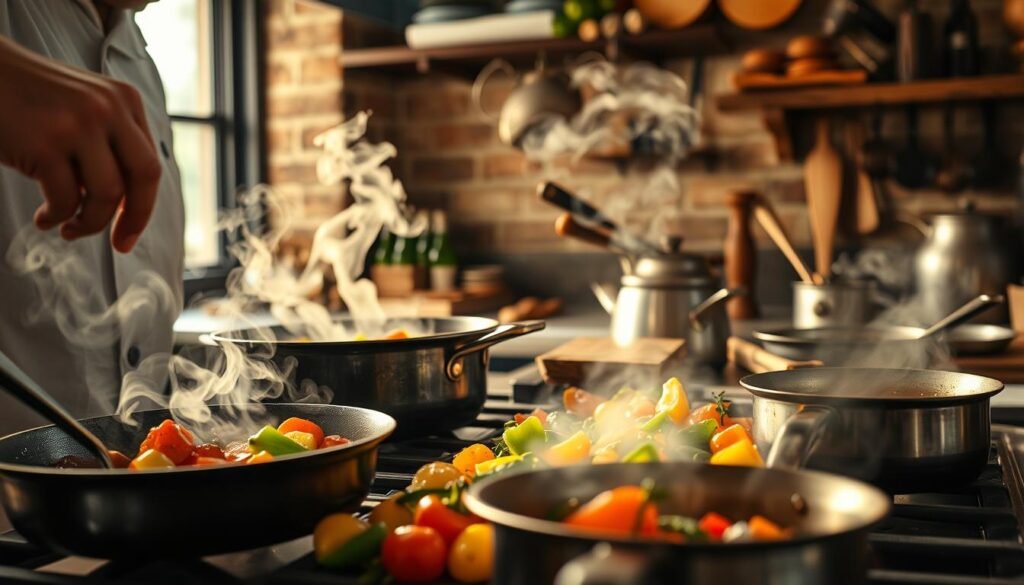
Roux: The Foundation of Cajun Dishes
A roux is a mixture of flour and fat (such as oil or butter) that’s cooked together until it reaches a desired color, ranging from pale blonde to dark brown. The color of the roux determines its flavor, with darker rouxs having a nuttier, more intense taste. Making a roux is both an art and a science, requiring patience and constant stirring to prevent it from burning. A good roux is the foundation of many Cajun dishes, including gumbo and étouffée, as it thickens the dish and adds depth to its flavor. Here are some tips for making a perfect roux:
- Use a heavy-bottomed pan to distribute heat evenly.
- Stir the roux constantly, as it can burn quickly.
- Adjust the cooking time based on the desired color and flavor.
By mastering these cooking techniques, you’ll be well on your way to exploring Cajun cooking traditions and creating delicious, authentic dishes that showcase the best of Cajun food New Orleans.
Where to Experience Cajun Cuisine in New Orleans
From historic restaurants to street vendors, New Orleans offers a diverse range of Cajun culinary experiences. Whether you’re a local or just visiting, you’ll find plenty of opportunities to indulge in the rich flavors of Cajun cuisine.
Historic Restaurants to Visit
New Orleans is home to some of the most iconic Cajun restaurants in the country. One such establishment is Dooky Chase’s Restaurant, a legendary eatery known for its authentic Cajun and Creole dishes. Be sure to try their famous gumbo, a staple of Cajun cuisine.
Another must-visit is Coop’s Place, a casual Cajun restaurant in the French Quarter. Their red beans and rice, along with their fried chicken, are local favorites.
| Restaurant | Signature Dish | Price Range |
|---|---|---|
| Dooky Chase’s | Gumbo | $15-$25 |
| Coop’s Place | Red Beans and Rice | $10-$20 |
Food Trucks and Street Vendors
For a more casual Cajun dining experience, look no further than the city’s food trucks and street vendors. You can find everything from cajun fries to crawfish étouffée being served up by vendors throughout the city.
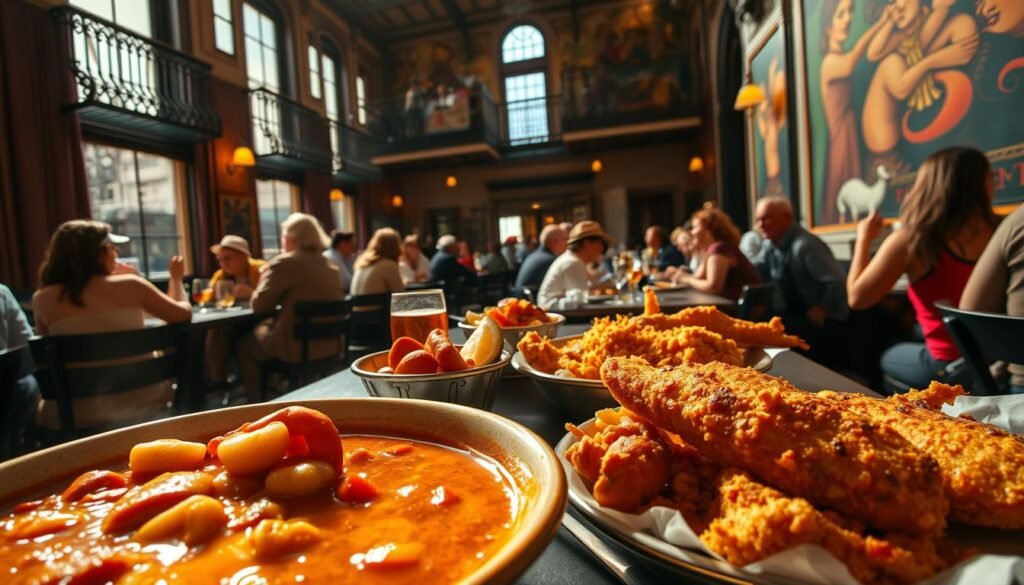
One popular spot is the French Market, where you can find a variety of vendors serving Cajun and Creole cuisine. Be sure to try some of the local specialties like beignets or pralines.
To experience the best of Cajun cuisine in New Orleans, be sure to explore both the historic restaurants and the more casual food trucks and street vendors. With so many options available, you’re sure to find something that suits your taste.
Cajun Cuisine and Local Culture
Cajun cuisine is more than just food; it’s the heartbeat of New Orleans culture. At its core, Cajun cuisine represents the community’s history, traditions, and values. It’s a cuisine that brings people together, whether at family gatherings, community events, or festivals celebrating Cajun heritage.
The Role of Food in Community Gatherings
In New Orleans, food plays a pivotal role in community gatherings. It’s not just about feeding the crowd; it’s about sharing love, tradition, and culture. Cajun dishes like gumbo, jambalaya, and crawfish étouffée are staples at these events, serving as a culinary bridge that connects generations and communities.
Community gatherings often revolve around food, with tables filled with an array of Cajun delicacies. These events are a testament to the power of food in fostering community spirit and cultural identity.
Festivals Celebrating Cajun Heritage
New Orleans and its surrounding regions host numerous festivals that celebrate Cajun heritage. These festivals are vibrant expressions of the community’s love for their culture and cuisine. The Breaux Bridge Crawfish Festival and Mardi Gras are just a couple of examples where Cajun cuisine takes center stage.
During these festivals, the air is filled with the mouth-watering aromas of traditional Cajun dishes. Visitors can indulge in a variety of foods, from spicy jambalaya to succulent crawfish, all while enjoying the lively music and dance that accompany these celebrations.
The significance of these festivals extends beyond the food; they are a celebration of the Cajun community’s resilience, heritage, and joie de vivre. Through these events, the community shares its culture with visitors, promoting cross-cultural understanding and appreciation.
| Festival | Location | Main Cajun Dish |
|---|---|---|
| Breaux Bridge Crawfish Festival | Breaux Bridge, LA | Crawfish Étouffée |
| Mardi Gras | New Orleans, LA | Jambalaya |
| New Orleans Jazz & Heritage Festival | New Orleans, LA | Gumbo |
In conclusion, Cajun cuisine is deeply intertwined with the local culture in New Orleans, playing a significant role in community gatherings and festivals. It’s a cuisine that not only reflects the community’s heritage but also brings people together, celebrating the rich cultural tapestry of the region.
Pairing Drinks with Cajun Food
Pairing drinks with Cajun food is an art that enhances the authentic taste of our local dishes. In New Orleans, where Cajun cuisine is a staple, finding the right beverage to complement our bold flavors is essential.
When it comes to authentic Cajun dishes, the choice of drink can significantly impact the dining experience. From the spicy kick of jambalaya to the rich flavors of gumbo, the right drink can elevate these dishes to new heights.
Popular Beverage Choices
Cajun cuisine is known for its bold flavors, and the drinks that accompany it are no less vibrant. Popular beverage choices include craft beers, classic cocktails, and sweet tea, each offering a unique way to complement the spices and seasonings found in Cajun cooking.
- Craft Beers: A crisp lager or a hoppy IPA can cut through the richness of dishes like crawfish étouffée.
- Classic Cocktails: A Sazerac or a Pimm’s Cup can add a sophisticated twist to a casual Cajun meal.
- Sweet Tea: For a more traditional Southern approach, sweet tea provides a soothing contrast to spicy Cajun flavors.
Regional Craft Beers and Cocktails
New Orleans is renowned for its vibrant craft beer scene and innovative cocktails. Regional craft beers and specialty cocktails not only complement Cajun cuisine but also enhance the overall dining experience. For more on pairing local dishes with classic cocktails, check out this article on Nola’s signature dishes meeting classic cocktails.
| Cajun Dish | Recommended Drink |
|---|---|
| Jambalaya | Abita Amber Beer |
| Gumbo | Sazerac Cocktail |
| Crawfish Étouffée | Hurricane Cocktail |
For those looking to explore more, the city’s numerous breweries and bars offer a wide range of options to pair with your favorite Cajun dishes. Whether you’re a local or just visiting, experiencing the blend of Cajun cuisine and New Orleans’ drink culture is a must.
Cooking Cajun Cuisine at Home
Bringing the flavors of New Orleans into your home kitchen is easier than you think, and it’s a great way to start exploring Cajun cooking traditions. With a few essential tools and some simple recipes, you can create delicious, authentic Cajun dishes that will transport you to the heart of Louisiana.
Essential Kitchen Tools
Before you start cooking, make sure you have the right tools for the job. Cajun cuisine relies heavily on a few key kitchen staples, including a large cast-iron pot or Dutch oven, a heavy-bottomed skillet, and a wooden spoon or spatula. These tools will help you prepare the rich roux and hearty stews that are characteristic of Cajun cooking.
- A large cast-iron pot or Dutch oven for slow-cooking stews and braises
- A heavy-bottomed skillet for sautéing and browning ingredients
- A wooden spoon or spatula for stirring and serving
- A spice rack with essential Cajun seasonings like paprika, thyme, and cayenne pepper
Recipes for Beginners
If you’re new to Cajun cooking, start with some simple recipes that showcase the flavors and techniques of this iconic cuisine. One-pot wonders like jambalaya and gumbo are great places to begin, as they’re easy to make and packed with flavor. You can also try your hand at making some classic Cajun sides, like grilled asparagus or hushpuppies.
Here’s a simple recipe for jambalaya to get you started:
“Jambalaya is a quintessential Cajun dish that’s perfect for feeding a crowd. It’s a one-pot wonder that’s easy to make and packed with flavor.”
- 1 lb sausage, sliced
- 1 lb chicken, diced
- 2 cups uncooked rice
- 2 cups chicken broth
- 1 can diced tomatoes
- 1 tsp dried thyme
- 1 tsp paprika
- Salt and pepper to taste
Combine all ingredients in a large cast-iron pot or Dutch oven, and cook over medium-high heat until the rice is tender and the liquid has been absorbed. Serve hot, garnished with chopped scallions and a dash of hot sauce.
By following these simple recipes and using the right tools, you’ll be well on your way to creating delicious Cajun cuisine at home. So don’t be afraid to experiment and try new things – and most importantly, have fun with it!
Conclusion: Embracing Cajun Flavors
As we wrap up our culinary journey through New Orleans, it’s clear that Cajun cuisine is more than just a style of cooking – it’s a reflection of the city’s rich history and cultural heritage. The bold flavors and spices that define New Orleans Cajun cuisine have captivated visitors and locals alike, making it a staple of Southern Cajun cuisine.
Exploring the Flavors
From the iconic dishes like jambalaya and gumbo to the lesser-known authentic Cajun dishes, there’s always something new to discover in the world of Cajun cooking. Whether you’re dining at a historic restaurant in the French Quarter or trying your hand at cooking Cajun recipes at home, the flavors and traditions of this cuisine are sure to leave a lasting impression.
Celebrating Cultural Heritage
Cajun cuisine is deeply rooted in the cultural identity of New Orleans, and its significance extends beyond the kitchen. It’s about community, family, and the joy of sharing meals together. As you continue to explore and appreciate New Orleans Cajun cuisine, we encourage you to embrace the spirit of culinary adventure that defines this vibrant city.
FAQ
What is Cajun cuisine, and how does it differ from other types of cuisine?
Cajun cuisine is a style of cooking that originated in Louisiana, characterized by the use of local ingredients, bold flavors, and spices. It differs from other types of cuisine in its unique blend of French, African, Spanish, and Native American influences.
What are some popular Cajun dishes I should try?
Some popular Cajun dishes include jambalaya, gumbo, crawfish étouffée, boudin, and andouille sausage. These dishes showcase the bold flavors and spices that define Cajun cuisine.
What is the Holy Trinity in Cajun cooking, and why is it important?
The Holy Trinity refers to the combination of onions, bell peppers, and celery that forms the foundation of many Cajun dishes. This trio of ingredients adds depth and complexity to Cajun cooking, and is often used as a starting point for a variety of recipes.
Where can I find authentic Cajun cuisine in New Orleans?
You can find authentic Cajun cuisine in New Orleans at a variety of restaurants, food trucks, and street vendors. Some popular spots include historic restaurants like Dooky Chase’s Restaurant and Cafe Maspero, as well as casual eateries and street vendors throughout the city.
What are some essential kitchen tools for cooking Cajun cuisine at home?
To cook Cajun cuisine at home, you’ll need a few essential kitchen tools, including a large cast-iron pot, a wooden spoon, and a spice rack with a variety of Cajun seasonings. A good roux-making technique is also essential for many Cajun dishes.
How do I pair drinks with Cajun food?
Pairing drinks with Cajun food can elevate the dining experience. Popular beverage choices include regional craft beers, such as Abita Beer, and cocktails like the Sazerac. You can also pair Cajun dishes with sweet tea or coffee for a more casual experience.
What are some traditional Cajun festivals and events I can attend?
New Orleans hosts a variety of festivals and events that celebrate Cajun heritage, including the Breaux Bridge Crawfish Festival and Mardi Gras. These events showcase the best of Cajun cuisine, music, and culture.
Can I learn to cook Cajun cuisine at home, even if I’m a beginner?
Yes, you can learn to cook Cajun cuisine at home, even if you’re a beginner. Start with simple recipes like jambalaya or gumbo, and practice making a good roux. You can also find a variety of Cajun cooking classes and online resources to help you get started.
